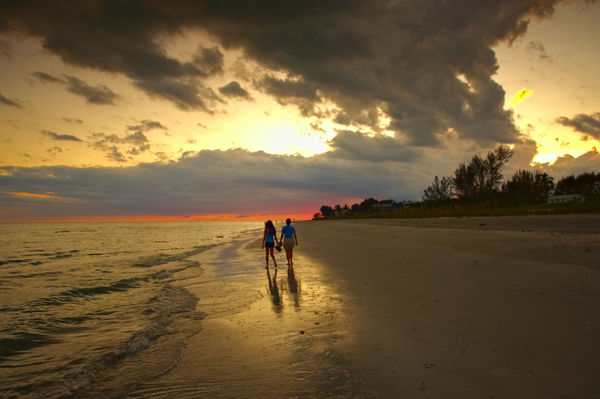Just a few minutes from downtown Fort Myers, Florida, Sanibel Island is a laid-back refuge that hearkens back to the “old” Florida. With several miles of beaches, warm Gulf waters and charming shops in addition to restaurants lining the palm-shaded streets, the island draws thousands of visitors every year.

- Sanibel IslandSasha Vasko / Foter / CC BY-NC
It’s not just the chance to kick back in a tropical retreat, though, that brings visitors to Sanibel’s sunny shores.
Sanibel Island is one of the world’s foremost destinations for seashells. The shores on the Gulf side of the island are piled high with seashells, ranging from common scallops and coquinas to the rarer junonia shells. The seashells are so abundant, in fact, that they have become a multi-million dollar industry on the island and led to the coining of the term “Sanibel Stoop” to describe the distinctive posture that beachgoers display when collecting the marvelous mollusks.
While it’s possible to collect dozens of intact, unusual shells simply strolling the beach with a bucket, serious shelling requires some preparation, planning and know-how. Your finds depend largely on the season, the weather and where on the island you start your hunt – but when you get all of the factors right, you’ll be amazed by what you can collect.
Sanibel Shells: A Primer
The entire west coast of the state of Florida is a sheller’s paradise, with hundreds of species washing up on the beaches from Panama City all the way to Naples. However, thanks to their unique positions, jutting out into the Gulf in southwest Florida, Sanibel Island and its neighbor, Captiva, collect millions of shells that travel through the waters during the winter months. While the shells do not entirely disappear in the summer, the southerly winds in the warmer months reduce the number of shells, making winter the ideal time to visit the island if you want to engage in some serious shelling.
The most common shells found on the shores are coquinas, which resemble small butterflies when they are opened; each side resembles a clam and features a white background with reddish-brown markings. Olive shells are also common, with their narrow, oval shape and glossy finish, as well as tulip and whelk shells. The rarest shells, which are highly sought after by collectors, are the junonia shells. Shaped like a cross between the olive shell and a whelk, the junonia has a milky white background covered with brown spots. The shells are so rare that anyone who finds one will have their photo taken for the local newspaper.
Where to Find Shells
When you stay at one of the top Sanibel Island resorts, chances are the concierge or manager will be able to clue you in on a “secret” spot where you can find some of the best shells. Even if they can’t provide that information, though, you can generally expect to find shells along any of the Gulf-facing beaches. The largest shells are usually found on the north end of Sanibel and on Captiva, which is connected by a narrow bridge; on the beaches near the Lighthouse end of the island is where you’ll find smaller shells.
When and How to Find Shells
For the greatest variety of shells, head to the beach on a winter’s day at low tide; the absolute best time is after a storm has passed through, depositing millions of shells on the shore. While you may be tempted to search the large piles of shells that ring the waterline, for the best specimens, you’ll have to actually go into the water. Wear water shoes to protect your feet, and carry a net and bucket to collect shells as they float through the water. Keep in mind, though, that it’s illegal to collect live shells in Florida, so if you grab a shell and it still contains a live animal, toss it back.
When you head back to your hotel, take time to clean your shells before you pack them in your suitcase to bring home as souvenirs. Soak the shells in warm water – preferably with a capful of bleach – to clean off the sand and remove odors.
Of course, if you can’t get to the beach, Sanibel Island is full of shops that offer all manner of shell-themed merchandise. For a true Sanibel experience, though, plan to spend at least a few hours perfecting your Sanibel stoop – you may just find the perfect souvenir of your Florida adventure.
A native of Wisconsin, Trish Olsen moved to the Fort Myers area five years ago. Drawn by the sunshine and sandy beaches, Trish spends as much time as she can on Sanibel, collecting shells for the unique works of art that she sells online and at local craft fairs.


